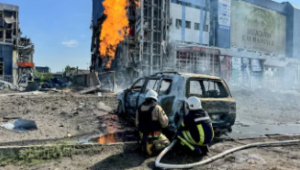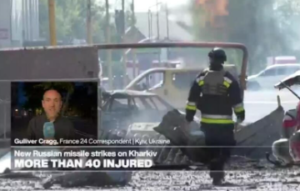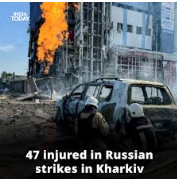Kharkiv , Ukraine – A devastating Russian missile attack on Ukraine’s second-largest city, Kharkiv, has left 47 people injured, including five children, as the conflict between Russia and Ukraine continues to intensify.
Russian Missiles Target Kharkiv: 47 Injured
On Sunday, at approximately 1pm local time (10:00 GMT), Russian forces launched a missile strike on Kharkiv, a city located near the Russian border. The attack targeted a busy shopping mall and a major sports center in the Saltivskyi and Nemyshlianskyi districts, causing widespread damage and leaving 47 people injured, including children as young as three months old. The missiles used in the attack were identified as Iskander missiles, known for their precision and destructive power.
Critical Injuries and Continued Threats
Kharkiv Mayor Ihor Terekhov confirmed that several of the injured are in critical condition, with local hospitals struggling to treat the high number of casualties. Rescue teams and ambulances responded immediately to the scene, but their efforts were hampered by additional strikes, which targeted the responders themselves. “The enemy launched a cynical repeat strike on our city … leaving doctors injured,” Mayor Terekhov said, condemning the attack as a deliberate act of terror.
Zelenskyy Demands Long-Range Weapons
In the wake of this attack, Ukrainian President Volodymyr Zelenskyy renewed his calls for Western allies to provide Ukraine with long-range weapons capable of striking deeper into Russian territory. Zelenskyy argues that these weapons are essential for neutralizing the Russian military threat and preventing further attacks on Ukrainian cities. “All the necessary forces of the world must be brought in to stop this terror,” Zelenskyy urged on his Telegram channel, emphasizing the need for global support.
Ongoing Conflict in Kharkiv and Broader Ukraine
Sunday’s missile strike is the latest in a series of brutal attacks on Kharkiv. Just days earlier, a Russian strike on an apartment block in the city killed seven people and injured dozens more. The continuous bombardment of civilian areas has exacerbated the humanitarian crisis in Ukraine, with thousands of civilians killed and countless more displaced since Russia’s full-scale invasion began in February 2022.
International Community Faces Tough Decisions
As the conflict in Ukraine escalates, the international community remains divided on how to respond. Russia’s relentless attacks, including the most recent strike on Kharkiv, highlight the ongoing danger to civilians and the urgent need for a coordinated global response. Despite Russia’s claims that it is only targeting military objectives, the high civilian casualty rate tells a different story.
In the past week alone, President Zelenskyy reported that Russia launched 160 missiles, 780 guided aerial bombs, and 400 attack drones across Ukraine. This surge in attacks has intensified calls for more decisive action from Ukraine’s allies, particularly in providing the necessary weaponry to defend against future strikes.
The situation in Kharkiv and across Ukraine remains dire, with no end to the violence in sight. As Ukraine continues to resist Russian aggression, the world watches closely, hoping for a resolution that will bring peace and stability to the region.

For ongoing updates on the Russia-Ukraine conflict and its global impact, stay informed with [Your News Source].
1. Official Statements and Reports:
- Ukrainian Government: Statements from President Volodymyr Zelenskyy, the Ukrainian Ministry of Defense, and local officials in Kharkiv could provide more context and updates on the situation.
- Russian Government: Official statements or denials from the Russian Ministry of Defense or the Kremlin might give insight into Russia’s perspective on the strike.
- International Organizations: The United Nations, NATO, and the European Union often release statements or reports on significant developments in the Russia-Ukraine conflict.
2. On-the-Ground Reporting:
- Local News Outlets: Ukrainian news sources like Ukrainska Pravda, Kyiv Post, or Hromadske often provide detailed, real-time updates.
- International Media: Major international news organizations such as BBC, Al Jazeera, Reuters, and The New York Times might have correspondents in the region providing additional insights and eyewitness accounts.
3. Casualty and Damage Assessments:
- Health and Medical Reports: Hospitals and healthcare providers in Kharkiv could offer details on the number and severity of injuries.
- Rescue Operations: Updates from emergency services and rescue teams could provide information on ongoing efforts to help those affected by the strike.
4. Historical Context:
- Previous Attacks: Information on past missile strikes in Kharkiv, including the type of missiles used, the frequency of attacks, and the areas most targeted, can provide a broader understanding of the ongoing conflict.
- Kharkiv’s Strategic Importance: Background on why Kharkiv is a significant target for Russian forces could help contextualize the attack.
5. Humanitarian Impact:
- Displacement and Refugee Data: Statistics on how the conflict has affected civilian populations in Kharkiv, including displacement figures and the state of refugee camps.
- International Aid Efforts: Details on humanitarian aid being provided to Kharkiv and the broader region, including contributions from NGOs and international governments.
6. Military Analysis:
- Missile Technology: Information on the Iskander missiles used in the attack, including their capabilities, previous usage in the conflict, and the implications of their deployment.
- Defense Strategies: Insight into how Ukraine is defending against missile strikes, including the effectiveness of anti-missile systems and potential future needs.
7. Geopolitical Reactions:
- Diplomatic Responses: Reactions from key global players like the United States, the European Union, and NATO could provide context on how the international community is responding to the latest escalation.
- Economic Sanctions: Information on any new sanctions or economic measures being considered in response to the attack.
8. Social Media and Public Reactions:
- Eyewitness Accounts: Social media platforms like Twitter, Facebook, and Telegram often have real-time reports and videos from people on the ground.
- Public Sentiment: Analysis of public sentiment in both Ukraine and Russia, including protests, support rallies, or other forms of civic action.
9. Long-Term Impact:
- Reconstruction Efforts: Plans for rebuilding damaged infrastructure in Kharkiv and how ongoing conflict might affect these efforts.
- Economic Impact: The effect of continued missile strikes on Kharkiv’s economy, including businesses, employment, and housing.
10. Expert Opinions:
- Military Analysts: Commentary from military experts on the strategic implications of the attack.
- Human Rights Organizations: Reports from organizations like Amnesty International or Human Rights Watch on the attack’s impact on civilians.






